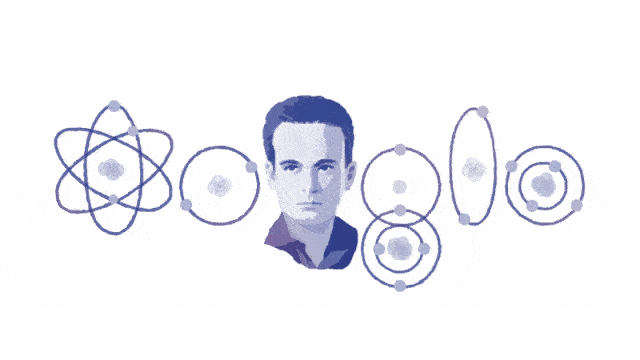Lifestyle
Interesting Facts about César Lattes, a Brazilian Physicist Who Discovered Pion

Google animated Doodle honors the 100th birthday of César Lattes, a Brazilian physicist and teacher who significantly contributed to our understanding of nuclear forces by discovering the π-meson, often known as the pi meson or pion. Lattes was born in Curitiba, Brazil, on July 11, 1924. Here are some interesting and fun facts about César Lattes you should need to know.
Who was César Lattes?
Cesare Mansueto Giulio Lattes, a Brazilian experimental physicist who went by César Lattes, was one of the scientists who discovered the pion, a composite subatomic particle consisting of a quark and an antiquark.
Brazilian physicist Césare Mansueto Giulio Lattes and American physicist Eugene Gardner of the University of California, Berkeley, verified the presence of heavy and light mesons created when alpha particles bombarded carbon nuclei in 1948.
Here is a look at the life and work of César Lattes
- Birth name: Cesare Mansueto Giulio Lattes
- Known for: Discovery of the Pion
- Birth date: July 11, 1924
- Birthplace: Curitiba, Paraná, Brazil
- Death on: March 8, 2005 ( 80 years old)
- Death place: Campinas, São Paulo, Brazil
- Cause of death: Cardiac arrest
- Residence: Brazil
- Parents:
- Mother name: Carolina Maroni
- Father name: Giuseppe Lattes
- Spouse: Martha Lattes
- Alma mater: University of Sao Paulo
- Religion: Agnosticism
- Fields: Physics
- Institutions:
- University of São Paulo
- Federal University of Rio de Janeiro
- University of Campinas
- Brazilian Center for Physical Research
- Bristol University
40 Interesting Facts about César Lattes
- Renowned Brazilian physicist Lattes played a pivotal role in the development of atomic physics in the country with his groundbreaking research.
- Along with being a key figure in the founding of the National Council for Scientific and Technological Development (CNPq), he was also a highly regarded leader in the Brazilian scientific community.
- On July 11, 1924, he was born into a family of Italian immigrants, Giuseppe Lattes (born in Turin, 1912) and Carolina Maroni Lattes (born in Alessandria), who had emigrated to Brazil in 1912 and returned to Italy in 1914 during World War I. After Lattes’ father returned to Brazil from his war, Giuseppe founded Banco Brasul, where the two first worked together.
- Their son Cesare Mansueto Giulio was baptized in the Catholic Church, although they were Sephardic Jews. Following their marriage, Giuseppe and Carolina went back to Brazil in 1921, while César came to the US School to pursue his studies.
- The family lived in Italy for six months during the Italian Revolution of 1930. In the French and Italian Bank, where his father worked as a manager, César got to know the scientist Gleb Wataghin, who would go on to become his mentor.
- In his early years, César Lattes had a private tutor in Porto Alegre from a teacher, and he later spent six months at the Menegapi Institute.
- After attending Colégio Dante Alighieri for high school from 1934 to 1938, Lattes’ father facilitated talks between him and Gleb Wataghin, a physics professor at the University of São Paulo. As a result, Lattes graduated from the university in 1943 at the age of 19, earning exceptional grades and making a name for himself in the experimental field.
- In actuality, Lattes is the result of one of the generations of physicists trained by Wataghin, including Oscar Sala, Sonja Ashauer, Jayme Tiomno, Marcelo Damy de Souza Santos, and Mário Schenberg.
- Lattes’ primary field of study, the study of cosmic rays, which were discovered in 1932 by American physicist Carl David Anderson, began between 1946 and 1948.
- In Chacaltaya, a mountain in the Andes of Bolivia, he established a laboratory more than 5,000 meters above sea level, where he recorded cosmic rays on photographic plates.
- César Lattes chose to travel to Bolivia on a Panair aircraft rather than a British one, and the British aircraft that was supposed to take him to South America crashed near Senegal.
- Thanks to his professor Occhialini, who had arrived the year before, he was able to fly to England in February 1946. There, he began working at the University of Bristol’s H. H. Wills Laboratory under Cecil Frank Powell, receiving a grant of fifteen pounds per month.
- There, he added more boron to Powell’s nuclear emulsion, making it better. He worked with Hugh Muirhead, Powell, and Occhialini in 1947 to find the pion (also known as the pi meson) experimentally.
- Powell had developed a new nuclear emulsion and asked the British company Ilford to add boron to it. In 1947, he made a significant experimental discovery with the aid of these plates: he discovered a new atomic particle called the π meson (or pion), which breaks down into a different kind of particle called the μ meson (mu meson or muon).
- César Lattes, Powell, and Occhialini determined the mass of the new particle in the same year.
- He went to a weather station in April 1947 at the summit of Bolivia’s 5,200-meter-high Chacaltaya mountain, where he used photographic plates to record the sun’s rays and uncover other “pion decay events.”
- César Lattes married Martha Siqueira Neto, a Pernambuco-born mathematician, in late 1947. The couple had four daughters together.
- One year later, Lattes collaborated with Eugene H. Gardner at UC Berkeley to identify artificial production of pions using the lab’s cyclotron, which involved subjecting carbon atoms to alpha particle bombardment. He was just 24 years old.
- César Lattes declined a Harvard offer and returned to Brazil in 1948 to take a position as a professor at USP. In addition, he worked as a researcher and professor at the Brazilian Center for Physics Research (CBPF) and the Federal University of Rio de Janeiro (UFRJ).
- Lattes made a comeback in 1949, this time as a researcher and professor at the Brazilian Center for Physical Research at the Federal University of Rio de Janeiro.
- Lattes was the lead researcher and the first author of the landmark Nature paper that revealed the pi meson, but Cecil Powell was the only one to win the 1950 Nobel Prize in Physics for creating a photographic technique to study nuclear processes, which eventually led to the discovery of mesons.
- César Lattes received at least five nominations for the Nobel Prize in Physics between 1949 and 1954. Lattes was nominated in 1951 by his former professor Wataghin.
- Lattes served as the CBPF’s scientific director in 1949. He worked as a geochronology researcher at the University of Pisa for a while in 1964.
- Following a brief additional stay in the United States Following a second tour as a visiting scholar at the University of Chicago (1955–1957), he returned to Brazil, where he joined the Brazilian Academy of Sciences (ABC) and took a job at the University of São Paulo’s Department of Physics.
- He moved to Campinas in 1963 and was involved in the founding of the Institute of Physics. Lattes took a full professorship at the newly established Gleb Wataghin Institute of Physics at the State University of Campinas (UNICAMP) in 1967. The institute was named for the founding professor of UNICAMP, which he had also assisted in building.
- In addition, César Lattes was appointed chairman of the Department of Leptons, High Energies, Chronology, and Cosmic Rays.
- Using nuclear photographic emulsion plates he devised and placed atop the Chacaltaya peak in the Bolivian Andes, he and his team measured the mass of the so-called fireballs, a spontaneous phenomenon that happens after high-energy collisions, in 1969.
- César Lattes retired in 1986 after being named professor emeritus and doctor honoris causa by the University of Campinas.
- He stayed in a home in the neighborhood close to the University of Campinas campus even after he retired. Marcelo Damy was considered the most significant Brazilian physicist by Lattes’ peers.
- At the age of 80, he died in Campinas, São Paulo, on March 8, 2005, after a heart attack.
- One of the most well-known and respected physicists in Brazil, Lattes’ contributions to the field of atomic physics were important.
- Along with being one of the primary forces behind the establishment of the significant Brazilian National Research Council (Conselho Nacional de Desenvolvimento Científico e Tecnológico), he was also a prominent scientific leader in Brazilian physics.
- Unicamp decided to honor him by renaming its central library the “César Lattes Library” in recognition of his contribution to this effort. Furthermore, the Lattes Platform, the Brazilian national scientific database, was named in his honor as well.
- Lattes was also awarded several honors during his lifetime. Lattes was recognized with numerous honors for his contributions to particle physics and nuclear forces, including an Order of Merit from Italy and Brazil as well as the Einstein Award from the Brazilian Academy of Sciences.
- Several Brazilian cities and colleges have streets and buildings named Lattes in addition to these awards.
- Additionally, César Lattes is listed as one of the few Brazilians in both the Encyclopædia Britannica and Isaac Asimov’s Biographical Encyclopedia of Science and Technology.
- Cecil Powell was awarded the Nobel Prize in Physics in 1950 for “his development of the photographic method of studying nuclear processes and his discoveries concerning mesons made with this method,” despite being the lead researcher and the first author of the landmark Nature article describing the pion. Until 1960, the Nobel Committee’s policy was to award the prize exclusively to the head of the research group, which explains the apparent neglect. In 1987, he was granted the TWAS Prize.
- In 1947, the theme of Estação Primeira de Mangueira’s samba-enredo was César Lattes.
- The name of César Lattes was added to the Book of Heroes and Heroines of the Fatherland on April 10, 2024.
- On July 11, 2024, Google featured an animated Doodle on its homepage to celebrate César Lattes.
-

 Gadget4 weeks ago
Gadget4 weeks agoAfter Grand Success on BLDC Ceiling Fan, Eff4 Is Launching Smart Bulb
-

 Festivals & Events4 weeks ago
Festivals & Events4 weeks agoGoogle Celebrates Cherry Blossom Season with Animated Doodle
-

 Business2 weeks ago
Business2 weeks agoPrakash and Kamal Hinduja: Driving Social and Environmental Change
-
Education3 weeks ago
Fred DuVal: University Leadership as a Critical Resource for Climate Change Research and Life-Saving Solutions
-

 Health2 weeks ago
Health2 weeks agoThe Hinduja Brothers Commitment to Global Health: Empowering Communities Across Borders
-

 Cryptocurrency3 weeks ago
Cryptocurrency3 weeks agoDesigned For The Masses: How Akasha (AK1111) Is Unlocking Crypto For The Next Billion Users
-

 Cryptocurrency3 weeks ago
Cryptocurrency3 weeks agoNexaglobal & Future World Token (FWT): Could This Be the Next Big Crypto Investment of 2025?
-

 Sports4 weeks ago
Sports4 weeks agoWomen’s NCAA Tournament 2025 Sweet 16: Full Schedule, Fixtures, Teams, Bracket, and How to Watch March Madness Basketball Match Live













